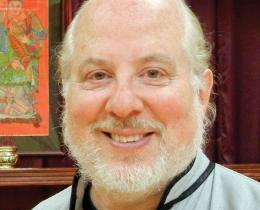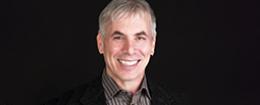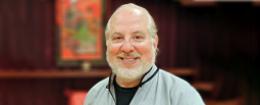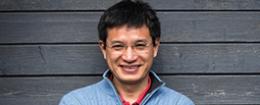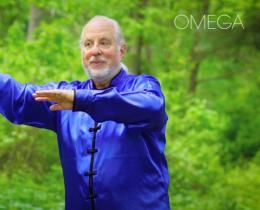Omega: Your work has been sponsored by the American Cancer Society, the Mayo Clinic, Health Canada, and numerous universities. What’s been the most surprising finding or most successful qigong treatment you discovered when working within the Western medical field?
Ken: That’s a big question. Let me start by saying what I think most readers will find surprising. I have lectured about and taught qigong in many medical schools and clinics, including some conservative oncology clinics. The reason my work is accepted is because I am willing to speak the language of science.
I love talking about qi as “flow of life energy.” But if I emphasize that to scientists, they will turn off and throw mental eggs at me. Instead, I summarize published, peer-reviewed evidence about what diseases qigong treats and how it works.
If I explain the effects of qigong on stress hormones, endorphin levels, and bone density, then minds open and I can gradually bring in Chinese cultural concepts. Physicians are aware of the limits of their profession; the key is to present alternative or complementary modalities rationally as part of our common attempt to relieve human suffering.
No one has all the answers. Physicians, nurses, and other healthcare providers have become, perhaps surprisingly, my most enthusiastic students.
In terms of successful treatments, since qigong healers are not licensed, I cannot claim to treat disease. However, qigong energy healing has produced some interesting and verifiable “side effects,” including remissions from numerous late-stage cancers, dramatic improvement in Parkinson’s symptoms, healing from diabetes, reduction in chronic pain, and speeding recovery from surgery. One hospital even commissioned me to produce a qigong meditation and healing imagery CD for use with patients pre- and post- surgery.
Omega: Can you talk about your participation in the Menninger Clinic's Copper Wall Project, which looked at the bio-electric fields of healers?
Ken: We live in a world where many people do not believe that a phenomenon is real unless it can be measured and has the stamp of approval of science. I actually don’t fully agree with this. People have always enjoyed quality of life precisely because they do not require scientific proof. Will the biology of love ever explain its mystery? Do we need to understand atomic physics to enjoy the warmth of the sun? You get my point.
Yet, science does have its place. It makes us accountable to facts and can be an antidote to the human talent at self-deception. Also, I have to quell my luddite tendencies when I remember how Western medicine has saved the lives of so many.
One of the pioneering experiments in the West to document measurable effects of subtle energies, such as qi, was conducted by the Menninger Institute of Topeka, Kansas from 1983-1995. It was called “Physical Fields and States of Consciousness” or more popularly “The Copper Wall Project.” First a team of scientists conducted 600 “control” experiments with volunteers who claimed no particular healing knowledge or ability.
Analyzing data from brain waves (EEG), body potential (electrostatic charge measured on the skin), and bioelectric fields nothing unusual was observed. The bioelectric fields were measured using sensitive electrometers attached to copper walls several feet away from the participants, hence the name Copper Wall Project, as well as a copper ceiling and copper sub-flooring.
To the scientists’ surprise, when fourteen known “sensitives” and “healers” were tested, they produced highly unusual anomalous phenomena. Brain waves shifted from the normal quick beta frequency to ultra-slow alpha, theta, and delta—a sign of intuition and deep relaxation. The amplitude of these waves, like the height of an ocean wave, was extremely high, indicating that more of the neurons were firing and working together.
Body potential, instead of remaining relatively stable as in the control experiments, surged from 4 to 221 volts. Yes, you heard me correctly. And equally astonishing, bioelectric fields around the participants jumped five volts or more, even on copper walls five feet away from the healers. As you may have read in my book, I was one of the healers and was as surprised as everyone else when I was allowed to see the experimental results about a year after the project was completed.
To put this in perspective, these electrical surges were 10,000 times greater than EKG voltages measured from the body’s most electrically powerful organ, the heart. The results were analyzed by noted scientists, such as physicist William Tiller of Stanford University, and published in peer-reviewed journals.
Omega: What is modern science getting right about preventative health and what is it still missing?
Ken: Modern science is to be commended for promoting the basis of preventive health care: diet, exercise, stress reduction, and strong social networks. Recent research in epigenetics also clearly demonstrates how changes in lifestyle and environment affect gene expression and suppression. Even if you have several generations of family members who had breast cancer, it is unlikely that you will activate the same genetic tendency if your habits of diet, thinking, and self-care are different. Very few diseases depend on one set of genes; rather they result from switches being turned on among several sets of genes. It is your behavior and environment that controls the switches.
The problem is that even if something is well known among researchers, it can take many years before it changes conventions of practice and doctor/patient interaction. People still complain far too frequently about their doctors, “They don’t listen to me. I didn’t know the medicine would have that side effect. I never heard about an alternative treatment.”
And the biggest deficit in Western medicine is its lack of preventive education for the patient. This is partly driven by the medical industry and partly driven by patients who expect doctors to “fix” them and are unwilling to take responsibility for their own health. It reaches absurd heights. My own dad, after developing Type 2 diabetes, was told by his physician that it didn’t matter what he ate as long as he took his insulin.
Many doctors become concerned with prevention only after the patient is ill, advising how to prevent recurrence or worsening of symptoms.
There was an ethical principle in ancient China that physicians should be paid to help a patient prevent disease. If the patient was ill, then either the patient, the physician or both had not done their jobs, and no payment was required.

